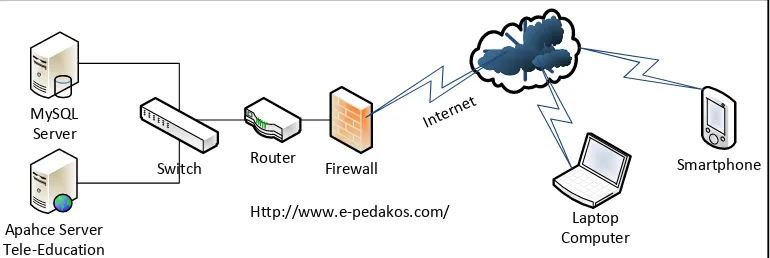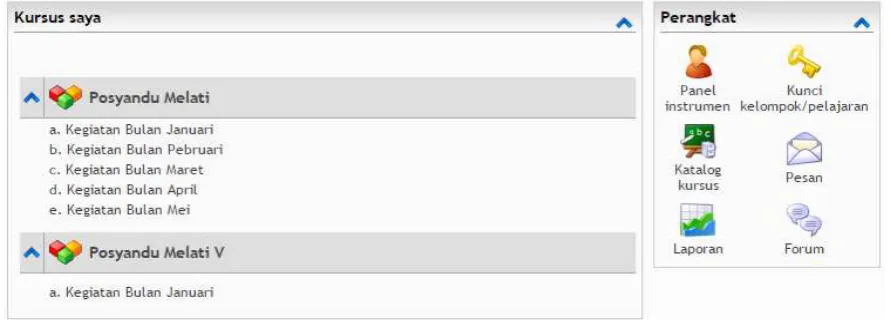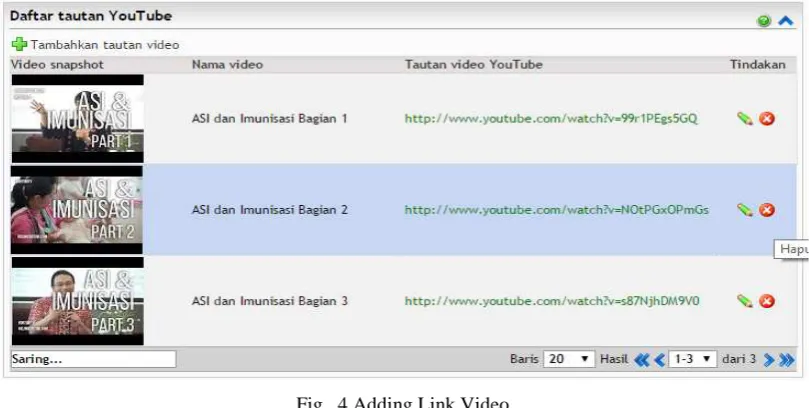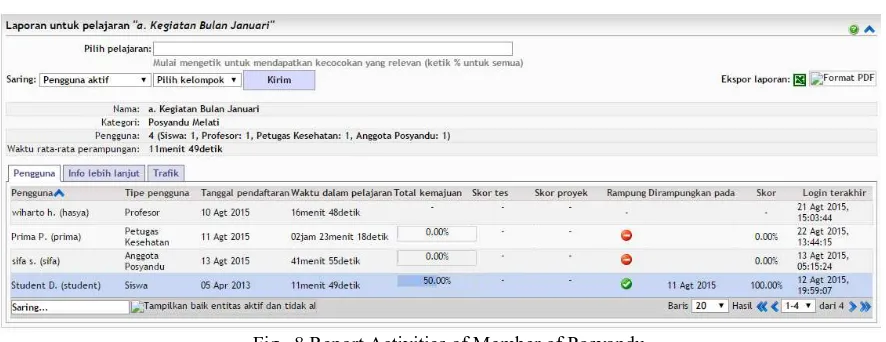DESIGN SYSTEM FOR EDUCATION & HEALTH
COUNSELING (E-PEDAKOS) POSYANDU IN
INDONESIA BASED E-LEARNING
Wiharto
1, Esti Suryani
1and Siti Fatimah
21
Department of Informatic, Sebelas Maret University, Indonesia
2Senior High School Insan Cendekia, Indonesia
wiharto@staff.uns.ac.id; suryapala@yahoo.com; sifa261982@yahoo.com
Abstract
The model system of education and maternal and child health counseling at the Posyandu has
been done with the direct model, namely Posyandu. The increasing number of women
working population affects the lessening number of participants as well as the effectiveness of
this activity. This study proposed a model of maternal and child health education and
counseling based on e-learning with a reference of electronic education and health counseling
(e-pedakos). This study was conducted in several stages. The first stage was the establishment
and development of e-pedakos systems and infrastructure. Subsequently, it was examined
related to the public’s attendance and responses, which was preceded by the training on how
to use E-pedakos. The last stage was the survey on system effectiveness. This counseling
model counseling of e-pedakos provides an alternative to resolve the weaknesses of
conventional posyandu. It promotes maternal education and counseling which can be done
anytime and anywhere.
Keywords: Posyandu, e-learning, e-pedakos, education, counseling, health.
Presenting Author’s biography
1.
Introduction
Results Demographic and Health Survey Indonesia (IDHS) maternal mortality rate (MMR) per 100,000 live births decreased gradually, from 390 (1991) to 334 (1997), 307 (2003), 223 (2007) and in 2012, published in 2013 jumped to 359, it is not much different from 22 years ago. Even when compared with neighboring countries in Southeast Asia, Indonesia ranks highest. The cause of high mortality are grouped into two, namely direct and indirect causing. Dominated the direct cause of bleeding (42%) eclampsia / preeklampsi (13%), abortion (11%), infection (10%), obstructed labor / obstructed labor (9%), and other causes (15%). While the indirect causes are educational level, socio-economic and socio-cultural low, too old (pregnant at the age above 30 years), is too young (pregnant at the age of 15-19 years, the highest percentage in the countryside), too often (pause childbirth ideally 2 years) and too much (the amount of labor should be below 3 or 4). Further still indirect causes are delays in taking decisions, too late to place the service and late to get help. Based on the descriptions the causes of high maternal mortality rate (MMR), either directly or indirectly cause, it can be summarized into three main problems are the weak points of health care during pregnancy, less the extent of access to health services and lack of knowledge about health.
Government in overcoming the lack of knowledge of maternal and child health, one way done with the Posyandu program. Posyandu is a health maintenance containers made of, by and for the people who mentored relevant officers, in a scope of PHC. (Department of Health, 2006). Posyandu is currently scattered across the village there were so many. Based on the information the Minister of Health in 2013 the number reached 310 737 Posyandu. Posyandu has two models of Posyandu for the health of mothers and children and the elderly Posyandu (posdula). Posyandu Services, in addition to preventive promotive well. One model is the extension promotive services and maternal and child health counseling. Education and counseling models used Posyandu generally using conventional methods. The conventional method is education and counseling are done immediately when the mother and daughter came to Posayndu, which is usually doing the weighing. Counseling and counseling kewehatan performed by personnel from the health center. Facts on the ground by taking samples of two Posyandu in Klaten regency Indonesia, was the level of presence of mothers in counseling and counseling with a very low percentage of approximately 50%. Absenteeism is caused by the level of busyness of mothers outside the home are high. This makes the Posyandu program in the form of counseling and counseling in order to improve maternal and child health knowledge with the conventional method is not optimal. Additionally there is a habit pattern of arrival to Posyandu were not the same, making it difficult to gather in the same time, it is also difficult to provide maternal and child health education.
The survey results Morgan Stanly stating significant increase in Internet users in the world, including Indonesia [1]. The development of the use of information technology is providing a lot of changes in various fields, khsususnya health. Much research has been done in the relevant use of information technology to support health care. Anderson et.al [2} and Lin et.al. [3], the research showed that the use of information technology had a significant impact, in terms of medical staff, patients, and the quality of health services. In addition, the use of information technology is able to provide broad jangkaun to access to health care with telemedicine models. Another benefit of the use of information technology can also be used to distribute health information, with the broad reach and flaksibel [2].
patient's medical data uploaded into the database, then the system recomender compare with Opera already initialized. Then the system will provide recommendations related to what needs to be done by the patient. In the study, in addition to recommendations also integrated with an e-learning system, to provide knowledge to patients about diabetes and how to manage them [5].
The study, almost the same, namely to support health promotion and consultation, in particular pregnant women who do Chen et.al [6]. Only in the study Chen et.al [6], proposes a system that has some of the functionality, the first collection of data is done in real time. The second data processing, data mining and a third of health services. The availability of the data collection makes doctors can commit early to the possibility of some acute and chronic diseases such as diabetes, fetal heart rate is abnormal and hypertension in pregnancy, so it can be detected early. Collection of data that is still raw so it needs to be processed, so that when it is provided to the doctor can be used for early detection and early action against such disorders. After detection, the next step is health care, which can include first aid, long-distance medical consultations, medication reminders, remote health care and health management [6].
In addition to research studies on the stretcher is a service SaaS (software as a service) Posyandu conducted by Bhaskoro et.al [7]. In that study proposed a model of SaaS applications Posyandu. Posyandu itself there are 2 types of Posyandu toddler and elderly Posyandu. In the study focused on the Posyandu toddler, namely Posyandu which focuses on maternal and child health services. The application of the model of development against the background of the large number of Posyandu were lying scattered in villages and diverse locations. The scattered layout that makes data synchronization difficult. This resulted in data that is used by the government related to maternal and child health became out of sync, so that when the data is used to make policy is not appropriate. In the study did not cover health services related to the functioning of Posyandu namely education and counseling.
2.
Methods
Research on the development of design education and counseling system model of maternal and child health at the Posyandu-based e-learning (e-pedakos) is divided into several stages. The first stage is the provision of network infrastructure and the development of e-pedakos, the infrastructure in question is the provision of a web server, database server, security systems and domains. Overview of system infrastructure shown in Fig 1. Further development of e-pedakos system, which is developing a system design of web-based education and counseling that has some ability. These capabilities are, supplying the material with a variety of media (text, files, video), discussion forums, announcements, education and counseling monitoring and scheduling the delivery of education and counseling. E-pedakos system can be accessed from a variety of communication terminals, the conditions available browser applications, such as Mozilla, googlecrome, IE and Opera.
The second step is to test the use of e-pedakos in two Posyandu in District Jatinom and North Klaten district, Klaten, Central Java, Indonesia. These stages are preceded by training in the use of e-pedakos to members, cadres and health workers Posyandu. Training is done by dividing the material into two groups, the first material that contains how to take advantage of e-pedakos of the members of Posyandu. Second, the material containing filling material in the system how e-pedakos, these materials devoted to the cadres and health workers from health centers. The material was given to the cadres and health workers include filling materials, either text, pdf files and videos. Further discussion either online or off-line, making announcements, scheduling access to the materials and reports Posyandu members in accessing the material. While the material is given to members of the Posyandu, including how to access the material, download the material in the form of pdf files and how to run the material in the form of video. In addition, the material provided to the member as well how to conduct discussions online or off-line as well as access to the announcement.
The last stage is to conduct interviews to assess the level of e-pedakos using systems in support of extension services and counseling services maternal and child health. Interview conducted at two locations Posayndu as a test, the Posyandu in Jatinom and North Kalten Klaten regency, Central Java, Indonesia.
3. Result & Discussions
E-pedakos
Kader Posyand
Members of Posyadu
Fig. 2 Context Diagram
E-pedakos system, has the ability to be used as a medium of education and counseling. The ability of the proposed system model, the first of each Posyandu can configure extension materials for each month, on each of the Posyandu and configuration is done by cadres Posyandu respectively, as shown in Fig 3. Posyandu exist in each district and was facilitated by the Center for Health (Puskesmas) local.
Fig. 3 Hierarchy of Education and Counseling
Fig. 4 Adding Link Video
Third, a discussion forum, a discussion can be done in two ways, namely by off-line and on-line. Online model, can be done if a cadre of health workers and members of Posyandu who want to conduct discussions in an on-line. Off-line, can be done at any time without having to see the position of discussion partners on-line or off-line. Both models such discussions to provide facilities for members and cadres Posyandu or pertugas health, so that they can choose from two models adapted to the circumstances and conditions. Display for the failitas shown in Fig. 5. The availability of this facility aims to educate members of Posyandu, to want to express what is not known, and what has not been understood relevant extension materials. It can also help to members, who expressed his shame if the problem directly at the time of counseling with conventional methods.
Fig. 5 Display of online Discussion
Fig. 7 Regulation of Scheduling Counseling Material
Lastly, Reports, understanding extension materials. Each member of the Posyandu study counseling material available in the system e-pedakos, members are given a menu, if it is understood, it can notify the system, so the system will provide a progress or mastery of the material. Progress can be reported to a health worker or health cadres. Report of the activities of members of Posyandu is shown in Fig. 8.
Fig. 8 Report Activities of Member of Posyandu
E-pedakos system, is being piloted in two districts in Klaten, the District of Klaten districts Jatinom and North, Klate regency, Central Java, Indonesia. Based on the results of the survey interview was conducted in two districts Posyandu produces some point, among others, the design model of e-pedakos system provides convenience in Posyandu activities for the participants Posyandu and health workers. With the design model of the e-pedakos contributes fairly to facilitate education and health consultations quickly. This is consistent with research conducted Anderson et.al [2], as with the e-pedakos system is able to provide convenience patients (Posyandu members), health officials, and the expansion of counseling services in particular.
4. Conclusions
Technology is developed to overcome the obstacle in the modern world and to make life easier. E-pedakos system is designed particularly for its flexibility in a variety of media education and counseling along with the development of information technology, so as to eliminate the weaknesses of the conventional methods in education and counseling. This design turns out to be very useful regarding with Posyandu activities sustainability, both for the participants and the neighborhood health center for the workers.
References
[1] S. Morgan. Internet Trends. http://www.morganstanley.com/. 2010.
[2] C. Anderson, T. Henner, and J. Burkey. Tablet computers in support of rural and frontier clinical practice. International Journal of Medical Informatics 82 , I046-I058, 2013.
[4] D. P. Simarmata, and S. H. Supangkat. Design and Implementation of Mobile Health Consultation between Doctors and Diabetes Patient. International Conference on Cloud Computing and Social Networking (ICCCSN) (pp. 1-4). Bandung West Java: IEEE. 2012.
[5] J. I. Hidalgo, E. Maqueda, J. L. Risco-Martín, A. Cuesta-Infante, J. M. Colmenar, and J. Nobel. glUCModel: A monitoring and modeling system for chronic diseases. Journal of Biomedical Informatics. 1-10, 2014.
[6] L. Chen, J.-J. Yang, Q. Wang, and M.-y. Wang. An Intelligentnformation System for Maternal and Child Health Care. IEEE Annual Computer Software and Application Conference Workshops (pp. 441-445). IEEE Computer Society. 2011.
[7] S. B. Bhaskoro, S. H. Supangkat, and I. B. Nugraha. Posyandu Cloud : Helathcare Networks to Support User-Oriented (Maternal and Neonatal) In Indonesia. IEEE (pp. 1-5). Jakarta: IEEE. 2011
[8] A. J. Romiszowski. The Selection and use of Instructional Media. London: Kogan Page. 1998.
[9] M. H. A. Rahman. Media pengajaran: Penghasilan bahan pengajaran berkesan. Serdang: Penerbit Universiti Putra Malaysia. 2000.



